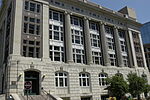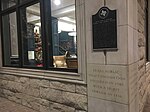Dewitt C. Greer State Highway Building
Art Deco architecture in TexasGovernment buildings on the National Register of Historic Places in TexasNational Register of Historic Places in Austin, TexasOffice buildings in Austin, TexasTexas Registered Historic Place stubs ... and 3 more
Texas building and structure stubsUse American English from November 2019Use mdy dates from November 2019

The Dewitt C. Greer State Highway Building is an eight-story structure in downtown Austin, Texas housing offices of the Texas Department of Transportation since its completion. Located at the southwest corner of 11th and Brazos Streets (125 E. 11th Street), the building was designed by San Antonio architect Carleton Adams and finished in 1933 at a cost of $455,000. It features elaborate Art Deco styling, including decorative carved limestone panels above the front doors. The building was added to the National Register of Historic Places along with the 1918 State Office Building in 1998.
Excerpt from the Wikipedia article Dewitt C. Greer State Highway Building (License: CC BY-SA 3.0, Authors, Images).Dewitt C. Greer State Highway Building
Brazos Street, Austin
Geographical coordinates (GPS) Address Nearby Places Show on map
Geographical coordinates (GPS)
| Latitude | Longitude |
|---|---|
| N 30.271944444444 ° | E -97.74 ° |
Address
Brazos Street 1010
78701 Austin
Texas, United States
Open on Google Maps










